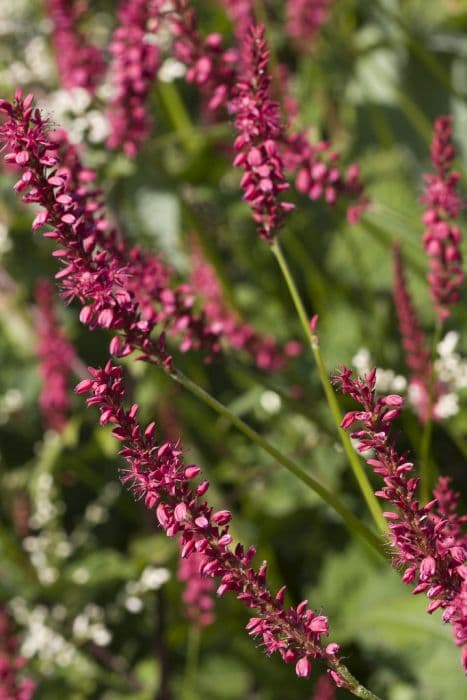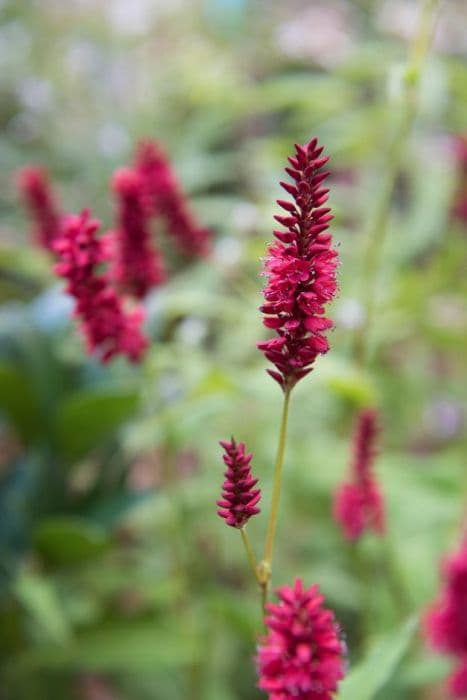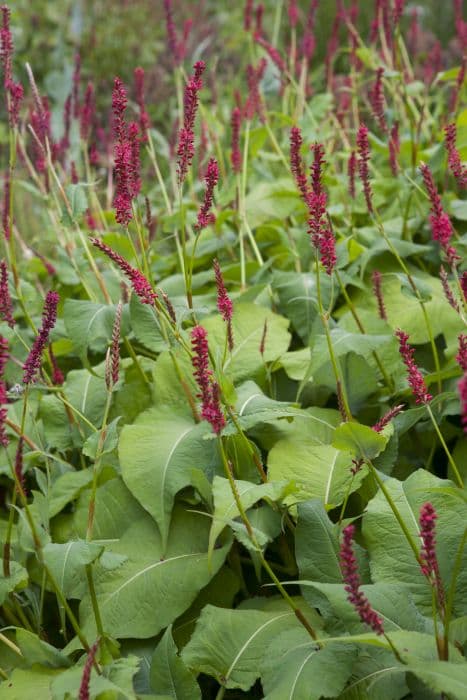Bistort Persicaria bistorta 'Hohe Tatra'

ABOUT
The plant known as Bistort 'Hohe Tatra' showcases a notable appearance with its serpentine, twisting stems that grace gardens with a sense of dynamism. Flourishing at the top of these stems are dense, poker-like spikes of small, delicate flowers. These blossoms come in a charming shade of pink, tinged with a rosy hue that provides a soft yet vibrant splash of color. The foliage of Bistort 'Hohe Tatra' is no less attractive, presenting broad, elongated leaves that possess a lush green color, and their edges are sometimes characterized by a subtle wavy pattern, adding textural interest to the plant's overall visual appeal. The leaves provide a rich backdrop for the cheerful inflorescences, making this plant an alluring addition to any garden that requires a touch of grace and color.
About this plant
 Names
NamesFamily
Polygonaceae.
Synonyms
Bistort, Snakeweed, Easter Giant, Adderwort, Dragonwort, Osterick, Twice-writhed.
Common names
Polygonum bistorta, Bistorta major, Bistorta officinalis, Persicaria bistorta.
 Toxicity
ToxicityTo humans
Bistort is generally considered non-toxic to humans. It has been used historically in traditional medicine and as a food source in various cultures. Consuming parts of the plant, such as the leaves or roots, is not commonly associated with poisoning or severe adverse effects. However, sensitive individuals may experience mild gastrointestinal upset if they consume large amounts of the plant.
To pets
Bistort is also generally considered non-toxic to pets. There is no widespread evidence to suggest that it poses a significant risk of poisoning to animals such as dogs and cats. As with humans, if a pet were to ingest a large quantity of the plant, it might experience mild gastrointestinal discomfort, but severe toxicity is unlikely.
 Characteristics
CharacteristicsLife cycle
Perennials
Foliage type
Deciduous
Color of leaves
Green
Flower color
Pink
Height
2 feet (0.6 meters)
Spread
2 feet (0.6 meters)
Plant type
Herb
Hardiness zones
4
Native area
Europe
Benefits
 General Benefits
General Benefits- Aesthetic Appeal: Adds vibrant pink flower spikes to the garden in late spring and early summer.
- Ecosystem Support: Attracts pollinators such as bees and butterflies, providing them with nectar.
- Low Maintenance: Once established, it requires minimal care, adapting to various soil conditions.
- Garden Design: Works well as a border plant or ground cover due to its clumping habit.
- Tolerance: Resistant to pests and diseases, improving garden health without the need for chemical treatments.
- Naturalization: Can spread and fill in areas over time, creating a natural, full look in landscaping.
 Medical Properties
Medical Properties- Astringent: The roots of Persicaria bistorta, commonly known as bistort, have been used traditionally for their astringent properties, which can help in tightening tissues and stopping bleeding.
- Anti-inflammatory: Bistort may possess anti-inflammatory effects which can be beneficial in treating conditions like sore throats and inflammations of the mucous membranes.
- Diarrhea treatment: Due to its astringent action, bistort has been used in traditional medicine to help with diarrhea and dysentery.
- Mouth and throat infections: It's been used in gargling solutions for treating mouth and throat infections because of its astringent and anti-inflammatory properties.
 Air-purifying Qualities
Air-purifying QualitiesThis plant is not specifically known for air purifying qualities.
 Other Uses
Other Uses- Dye source: The roots of Persicaria bistorta can yield a natural dye, which was traditionally used to color leather and fabrics a reddish-brown hue.
- Insect repellent: Plant extracts or the crushed leaves can sometimes be used as a natural insect repellent to ward off certain pests in the garden.
- Soil erosion prevention: Due to its dense growth and extensive root system, Persicaria bistorta can assist in stabilizing soil and preventing erosion on slopes or riverbanks.
- Culinary garnish: The flowers, which are visually appealing, can be used as a garnish to decorate salads and other dishes.
- Educational tool: It can be used in schools or ecological studies as a perfect example of a perennial plant that has adapted to various environmental conditions.
- Photography subject: Its aesthetically pleasing pink spikes of flowers make it a popular subject for plant and garden photographers.
- Flower arranging: The flowers can last quite a while when cut, making them suitable for inclusion in floral arrangements.
- Companion planting: As a hardy perennial, it can be planted alongside other moisture-loving plants to create diverse and attractive bog garden settings.
- Indicator species: Because it prefers damp conditions, the presence of Persicaria bistorta can indicate high moisture levels in the soil, useful in ecological surveying.
- Craft material: The stems and flowers can be dried and used in craft projects, such as for creating natural potpourri or decorative wreaths.
Interesting Facts
 Feng Shui
Feng ShuiThe Bistort is not used in Feng Shui practice.
 Zodiac Sign Compitability
Zodiac Sign CompitabilityThe Bistort is not used in astrology practice.
 Plant Symbolism
Plant Symbolism- Healing: The Persicaria bistorta, also known as Bistort, has a long-standing association with healing due to its medicinal properties that have been used traditionally to treat various ailments.
- Protection: In folklore, Bistort was believed to have protective qualities and was often used in rituals and amulets to ward off evil.
- Persistence: The hardy nature of Bistort, capable of thriving in tough conditions, symbolizes persistence and the ability to endure adversity.
- Purity: With its delicate blooms and serpentine roots, it is often viewed as a symbol of purity and cleansing, likely due to its use in herbal medicine to purify the body.
 Water
WaterThe Bistort (Persicaria bistorta 'Hohe Tatra') should be watered deeply to encourage root growth, providing about 1 gallon per plant weekly during its growing season in spring and summer. Reduce watering to every other week, with the same amount, when the plant is dormant in fall and winter. If rainfall is sufficient, you can cut back on manual watering. It's important to avoid waterlogging, so ensure the soil is well-draining.
 Light
LightThe Bistort thrives in full sun to partial shade conditions. It is best situated in a spot that receives morning sunlight and is partially shaded in the afternoon. This ensures that the plant gets enough light without being exposed to the potentially damaging effects of intense afternoon sun.
 Temperature
TemperatureBistort plants prefer temperate climates and can typically survive in temperatures ranging from 35 to 80 degrees Fahrenheit. The ideal temperature for actively growing Bistort plants is between 60 and 70 degrees Fahrenheit. These plants are hardy and can endure occasional dips below the minimum temperature but should be protected from prolonged freezing conditions.
 Pruning
PruningPruning Bistort plants is mainly for aesthetic shaping and removal of spent flower spikes to encourage additional blooming. Trim the foliage lightly in late winter or early spring before new growth begins. Deadhead regularly during the blooming season to maintain a neat appearance and promote further flowering.
 Cleaning
CleaningAs needed
 Soil
SoilBistort thrives in a moist, fertile soil with a mix of two parts garden soil, one part compost, and one part peat or leaf mold to ensure adequate moisture retention. The ideal pH for Bistort is slightly acidic to neutral, ranging from 5.5 to 7.0.
 Repotting
RepottingBistort generally does not require frequent repotting as it is a perennial. It should only be repotted or divided if it outgrows its space or to rejuvenate an overcrowded clump, typically every 3-5 years.
 Humidity & Misting
Humidity & MistingBistort prefers moderate to high humidity levels but is adaptable to various humidity conditions in the garden setting and does not require specific humidity adjustments when grown outdoors.
 Suitable locations
Suitable locationsIndoor
Ensure moist soil and bright, indirect light for Bistort indoors.
Outdoor
Plant Bistort in partial shade, keep soil moist.
Hardiness zone
4-9 USDA
 Life cycle
Life cyclePersicaria bistorta 'Hohe Tatra', commonly known as Bistort, typically begins its life cycle with seed germination in the spring, which requires moist, fertile soil and adequate warmth. After sprouting, the plant enters a vegetative growth phase, establishing a rosette of leaves and a strong root system. As the season progresses, Bistort produces tall flower stalks adorned with dense spikes of small, pink flowers by late spring or early summer, marking its reproductive phase. After pollination, typically by insects, the plant develops seed capsules that release seeds once matured, thus enabling the potential for dispersal and new plant establishment. In autumn, the above-ground foliage dies back as the plant enters dormancy, relying on its underground structures to survive the winter months. The following spring, the plant regrows from its perennial rootstock, repeating the annual cycle of growth, reproduction, and dormancy.
 Propogation
PropogationPropogation time
Spring to early summer
Propogation: Persicaria bistorta 'Hohe Tatra', more commonly known as Bistort or Snakeweed, is often propagated through division, which is typically the most popular method for this plant. This process is best carried out in spring, shortly before the new growth starts, or in early fall when the plant is not in active growth. To propagate by division, carefully lift the plant from the ground with a spade, ensuring a substantial amount of the root ball is intact. Then, using a sharp knife or spade, divide the clump into smaller sections, making sure that each section has at least one growth point or shoot. These sections can then be replanted immediately into well-prepared soil, spaced about 15 to 18 inches (approximately 38 to 46 cm) apart, and watered thoroughly to establish the new plants.









